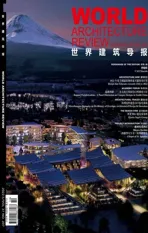欧洲犹太学术中心
2022-11-16
建筑设计:SSP Rüthnick Architekten | 地点:德国波茨坦
Design Company: SSP Rüthnick Architekten | Location: Potsdam,Germany


SSP Rüthnick 建筑事务所对无忧宫公园北门大楼和西侧毗邻的前橘园进行了改造翻新。这是大屠杀后中欧第一个拉比和领唱学术教育中心,给建筑师带来了特别的挑战:“设计神圣空间是一个极其特别的过程!”。波兹坦的第一座犹太教堂设有50 个座席,位于保护遗址群的中心。该犹太教堂的艺术性(由艺术家SEO 创作)赋予空间别样魅力,引人瞩目,需要更多的综合性设计工作。
该神圣空间位于一处保护建筑遗址(以前是一个马厩)内。《律法书》搭配着镌刻了轻盈线条的七个犹太教烛台,这种独具匠心的照明设计使该犹太教堂别具一格。另外还有一处诵经坛,由透亮的纤维混凝土建成,象征永恒之光(nerTamid)。崭新的欧洲犹太学术中心由两部分组成——位于北门大楼的Abraham Geiger 学院和Zacharias Frankel 学院,以及位于前橘园的犹太神学院。前橘园(长30 米)的结构曾有数次更改,比如,在民主德国时期被改造为体育馆。应恢复橘园昔日特征,从而再现其最初的用途。通过综合各种当代方法,来实现这一目标。
南面现有的幕墙被完全拆除,改造为玻璃幕墙。由裸露混凝土制成的现代细长结构与现有结构融为一体,成为屋中屋。位于新的玻璃幕墙和屋中屋之间的“缓冲区”为学生打造了休息区和自修区。机械式的通风装置,连同外部追随阳光而调整位置的遮阳篷,创建了舒适温馨的微气候。彩色印制的玻璃幕墙营造出光效应——建筑艺术竞赛的成果(由艺术家Eva Leitolf 创作)——进一步提高了空间质量。除了新的建筑物以外,保护遗址群也倍受重视——新宫——包括建筑物的历史发展过程。其建筑师是Carl von Gontard (1731-1791)。北门大楼兴建于1768 至1769 年之间,是皇家园丁的休憩场所。而今,它是办公室和研讨室的所在地,满足了当代学习与工作的全部需要。来自世界各地的学生、演讲者以及管理人员可畅通无阻地进入充满生气的犹太教堂、研讨室和演讲厅;在橘园设置了宽敞的休闲区,学生和讲师可在此进行沟通和交流;还包括自修区和优质户外休息区;在研讨室和办公室,可将宫殿美景尽收眼底。这是一个具有国际影响力的灯塔项目,可提供学习、祈祷与交流的空间。
At the Sanssouci Palace Park,the North Gate Building and the adjoining former Orangery to the west were converted and refurbished by SSP RüthnickArchitekten.The first academic education center for rabbis and cantors in Central Europe after the Shoah confronts the architects with a special challenge: "The design of the sacred space was a very special development!"Potsdam's first synagogue with 50 seats is located in the center of the listed ensemble.The art (by the artist SEO) in the synagogue gave the space another special attention and required additional integrative design work.
The design of the sacred space is in a listed building,a former stable.A special lighting design gives the synagogue a unique look,a Torah with a 7-arms menorah in light lines engraved.And a Bimah with lighted fiber concrete as the eternal light,nerTamid.The Abraham Geiger College and Zacharias Frankel College are located in the North Gate Building,and the School of Jewish Theology is located in the former Orangery–together they form the new European Center for Jewish Scholarship.The former Orangery (with a length of 30 meters) was structurally changed several times,such as the conversion to a gym during the GDR era.The original use should be recognizable again by getting back the character of an Orangery.This was done associatively and with contemporary means.
The current south facade was completely dismantled and renewed as a glass facade.A modern,elongated structure made of exposed concrete fits into the existing structure as a house within a house.In the "buffer zone",between the new south façade and the house within the house,lounge areas and self-study areas were created for the students.A pleasant microclimate was created,where ventilation is mechanical,with an external sunshade that adapts to the position of the sun.The light effects from the multicolored printed glass façade– the result of the art-in-architecture-competition (by the artist Eva Leitolf)– further enhances the quality of the space.In addition to the new architecture,the focus is on the listed ensemble– the New Palace– and thus the historical development of the buildings.Its architect was Carl von Gontard (1731-1791).The North Gate Building was erected in 1768/69 as a lodge for the court gardener.Today,it houses offices and seminar rooms that meet all the requirements of contemporary learning and working.Providing for students,lecturers and stafffrom all over the world a vibrant synagogue and seminar room above and lecture halls accessible without barriers;a spacious lounge area in the Orangery for exchange between students and lecturers;self-study areas and high quality outdoor lounge;seminar and office rooms with a view of the Park.It’s a lighthouse project with international impact,to provide a space for the study,prayer and exchange.



